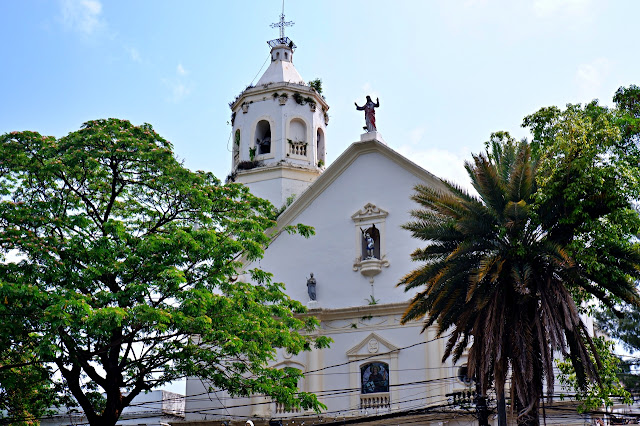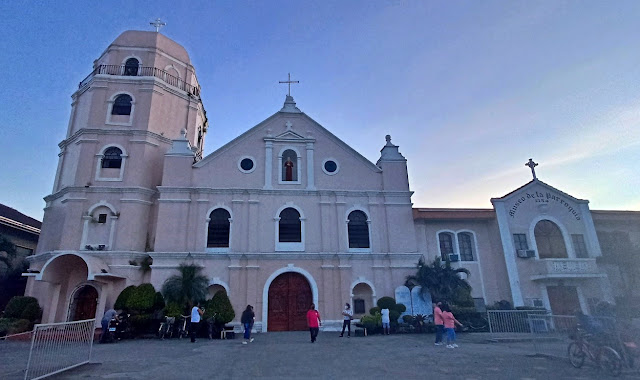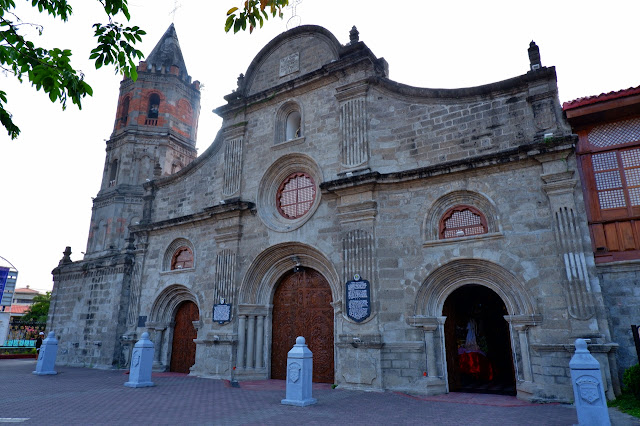Bulacan boasts some
of the oldest churches, dating back centuries, and it remains
one of the most popular Visita Iglesia sites during Holy Week. So, if you're
headed north of Luzon for the conclusion of the Lenten season, make a stop in the
province of Bulacan to complete your Visita Iglesia for Holy Week.
To help you plot
your route, here are 7 churches that you can easily pass by since they are within
municipalities and cities located adjacent to each other.
 |
| The Barasoain Church in Malolos is always a must-include Visita Iglesia destination |
St. Francis of Assisi Parish Church (Meycauayan)
Even when we were
still living in Parañaque City in the South of Metro Manila, this church played
the setting of numerous occasions with relatives. I’ve had cousins who got
married here, had their baptismal here and also where my grandfather and grandmother’s
funeral service were held. Now that we have settled in Meycauyan near my
maternal relatives, I’ve gotten closer to this church and would occasionally attend
mass like the Simbang Gabi here.
 |
| I've a lot of memories here of weddings, baptisms and even funerals of relatives |
The St. Francis of
Assisi Parish Church, one of Bulacan's oldest parishes, precedes even the
Malolos Cathedral. It was founded in 1578 by the Franciscans on a separate site
in what is now Brgy. Bahay Pare. The parish was relocated to its current
location in 1668, and the foundation for the present-day structure formed
during its third reconstruction in 1956. Since then, the church has seen minor
restoration and retrofitting.
St. Michael the Archangel Parish (Marilao)
 |
| Marilao Church |
A favorite tambike (a slang for cycling pit stops) of mine since it is located next town to us in Meycauyan. At first glance, the San Miguel Arcangel Church may appear as one of the typical Spanish-era churches with its Baroque-style architecture. However, once you stepped inside, you'll discover a couple of unique features of the church.
 |
| I've only seen this kind of bell inside a church for only just a few times before |
First, there's a stone relic from the cave believed to be where the 492
AD apparition of Saint Michael happened. Another interesting church piece that
you don’t see often anymore today is the Rueda de campanas or wheel bells. These
kinds of bells were usually rung during mass before they were replaced by
smaller hand-held bells.
Shrine of St Andrew
Kim (Bocaue)
 |
| Saint Andrew Kim was beatified by Pope Pius XI in 1925 and canonized by Pope John Paul II in May 1984. |
On the day I visited this church was also the first time I learned about it. This quirky-designed Catholic Church was built in honor of Saint Andrew Kim Taegon, a Korean-born Catholic priest who spent time in Lolomboy, Bulacan after escaping the persecution of Christians in Korea during the tail-end of the Joseon Dynasty in the early 19th century. He would then go to Macau and Shanghai before returning to Korea to evangelize his countrymen before being arrested and executed at the age of 25 in 1846.
St. Martin of Tours
Parish (Bocaue)
 |
| The Church was undergoing renovations when we visited. Hope it looks better right now |
The Saint Martin of
Tours Parish Church, also known as the Diocesan Shrine of the Holy Cross of
Wawa, is a Roman Catholic church in Bocaue, Bulacan, Philippines. The church is
one of Bulacan's oldest, built by Franciscan missionaries in 1606. It houses the
Holy Cross of Wawa, a wooden relic regarded as miraculous by followers and is celebrated
every year during the Bocaue River Festival.
Parish of San
Pascual Baylon and National Shrine of Nuestra Señora Inmaculada Concepcion de
Salambao (Obando)
A little bit out of
the way if you start your Visita Iglesia in Meycauyan, since Obando is
accessible via Malanday in Valenzuela, still, Obando Church of the Parish of
San Pascual Baylon and National Shrine of Nuestra Señora Inmaculada Concepcion
de Salambao, remains a good addition to your Bulacan Visita Iglesia.
 |
| Obando Church is also a favorite tambike stop of cyclists on their way to Malolos |
Founded by
Franciscan missionaries, the church serves as the centerpiece of the three-day
Obando Fertility Rites, which is celebrated annually in honor of three patron
saints: St. Pascual Baylon, St. Claire of Assisi, and Our Lady of Salambao.
Jose Rizal mentioned this festival in Chapter Six of his novel, Noli Me
Tangere. Every May, parishioners and other devotees, particularly women who
aspire to become pregnant, perform the three-day Obando Fertility Dance within
the church, which is followed by a public procession.
Diocesan Shrine and
Parish of Nuestra Señora de la Asuncion (Bulakan)
The Diocesan Shrine
and Parish of Nuestra Señora de la Asuncion, also known as the Bulakan Church,
is a 19th-century Neo-Byzantine-Romanesque stone church. It is one of the
parishes of the Roman Catholic Diocese of Malolos' Vicariate of the Immaculate
Conception. The National Historical Institute, the forerunner of the National
Historical Commission of the Philippines, designated the church as a Marked
Historical Structure of the Philippines in 2007.
 |
| The façade of Bulakan Church has a fortress-like appearance |
The Augustinian
Fathers established the parish and its first church in 1575 as a sub-parish of
Tondo. In 1578, Bulakan was declared a separate parish from Tondo. According to
the historical plaque, the Bulakan Church was burned down during the British invasion
of 1762. The chapel was the site where
Filipino general Gregorio del Pilar discreetly distributed pamphlets created by
his uncle, Marcelo H. del Pilar, a key member of the Propaganda Movement in the
late 1800s.
National Shrine
& Parish of Divine Mercy (Marilao)
Although the church itself has an ordinary looking façade, the magnitude of its presence to its congregation and devotees becomes apparent as soon as you go around the back.
 |
| A towering Divine Mercy statue serves as the centerpiece of all faith-based activities within the church |
A replica of Calvary, complete with life-size sculptures of the Stations of the Cross, can be found in the rear of the church. Many visitors seek solace in the healing waters of the Guadalupe Chapel, located in the church's basement, where an image of Our Lady sits atop a throne. Saint Faustina Hall, an auditorium that hosts Sunday Masses because of the shrine's vast population of church goers, the Rosary Hill, the Grotto of Our Lady of Lourdes, where visitors can pray for health, and the Grotto of the Resurrection, and retreat house completes the structures found around Church's compound.
 |
| The modest exterior of National Shrine & Parish of Divine Mercy |
Expect to be in the midst of a thick crowd during Holy Week when you come for your Visita Iglesia.
Our Lady of Mount
Carmel Parish or the Barasoain Church (Malolos)
Kids from the 1980s
would always link the Barasoain Church with the old 10-peso bill. For history
buffs, however, this church will always be remembered as the "dungeon of
the defiant," with its walls and four corners serving as a gathering place
for anti-colonial Ilustrado and Philippine Revolution heroes.
 |
| Barasoain Church is one of the main attractions in Malolos' Heritage District. |
Our Lady of Mount
Carmel Parish, also known as the "cradle of democracy in the East,"
is where the Malolos Constitution was ratified on January 21, 1899, and the
First Philippine Republic was inaugurated a few days later on January 23, 1899,
in addition to serving as the legislative building of the Philippine Government
led by Gen. Emilio Aguinaldo.
Immaculate
Conception Parish-Cathedral and Minor Basilica (Malolos)
One of the oldest
parishes in the country consecrated to the Immaculate Conception, the Malolos
Cathedral was founded in 1580 by the Augustinian friars.
 |
| The interior leading to the altar of Malolos Cathedral |
The church was
where Spanish Governor General Valeriano Weyler met with the twenty women of
Malolos in 1888; a meeting that led to the granting of permission for Filipinas
to study Spanish for the first time.
During the
Philippine Revolution and the early days of the First Philippine Republic, the
convent of the church was transformed into President Emilio Aguinaldo's palace.
The church was elevated to the status of cathedral of the diocese of Malolos in
1962.
The designation of
minor basilica was bestowed upon the church during the Centennial Year of the
Philippines' Independence (1898-1998). Along with the Manila Cathedral, it is
one of just two Philippine churches that considered a minor basilica and a
cathedral at the same time.






















